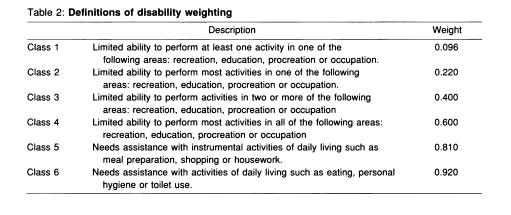Disability Adjusted Life Years (DALY) – Measuring the burden of disease in a population
Why measure the burden of disease?
1. To aid in setting health service priorities
2. To aid in identifying disadvantaged groups and targeting of health interventions;
3. To provide a comparable measure of output for planning and evaluation.
DALYs as a measurement tool
1. Burden of disease is measured in terms of TIME
• i.e., The TIME of healthy living lost due to disease or premature death
2. The age and sex of the person affected by disease, disability and death is considered while calculating the burden of disease and death.
3. Treating like health outcomes as like
• E.g. the death of a 40-year-old woman in Africa should contribute the same amount to the global burden of disease as the death of a 40-year-old woman in Europe
The ‘time lived with disability’ is combined with ‘time lost due to premature death’ to calculate number of DALY’s lost.
1. Time lived with disability is termed as ‘years lost to disability’ or YLD
2. Time lost due to premature death is termed as ‘Years of lost life’ or YLL
Hence DALY lost = YLL + YLD
‘Years of life lost” or YLL are calculated by
• defining an upper limit to life (global life expectancy) and
• calculating the years lost due to each death as
• the upper limit minus the age at death
The Potential upper limit of life or global life expectancy (LE) has been agreed to be the current Japanese LE as this is the highest among all countries.
E.g.: number of deaths at age 12 in the given year in a community is 35,900 and that at 23 yr. is 37,000
YLL at 12 yr. would be= 35,900 X (LE - 12)
YLL at 23 yr. would be= 37,000 X (LE - 23)
Age-weighting and discounting is then done for each age to derive the final value but the steps are beyond this discussion
Similarly YLLs at all ages are calculated for the year for the particular population and added up to get the total YLLs for the given time period
Note: Potential years of life lost should be calculated based only on deaths over age 1 to avoid being too heavily affected by infant mortality.
‘Years lost to disability’ (YLD) are calculated as:
Six disability classes have been defined between perfect health and death.
Each class represents a greater loss or increased severity than the class before. Each class is given weightage from 0 to 1
Time lived in each class is multiplied by the disability weight to calculate the years lost to disability (YLD)
Remember that the disability may be temporary like being bedridden due to typhoid fever, or permanent like losing a limb.
E.g. YLD due to typhoid = total cases of typhoid in the year X (0.6) X average duration of typhoid (in yrs.)
Assuming that typhoid fever limits the ability to recreate, procreate or attend to occupation and education i.e. class 4 disability.
An average duration of 3 weeks in the given yr. for the population can be considered as 3/52 yr.
Adding all YLDs due to different causes will yield the total YLD for the year for the given population
DALY = YLL + YLD
One DALY can be thought of as one lost year of "healthy" life
DALY for each cause are calculated as the sum of the Years of Life Lost (YLL) due to premature mortality in the population due to the cause and the Years Lost due to Disability (YLD) resulting from the same cause or its consequences
It was seen that psychiatric and neurologic conditions account for 28% of all years lived with disability (YLD), but only 1.1% of years of life lost (YLL). Thus, psychiatric disorders, which were traditionally not regarded as a major epidemiological problem, are shown by consideration of disability years to have a huge impact on populations by way of DALY lost due to them.
The DALY was first conceptualized for the World Bank in 1990. It is now a key metric employed by the United Nations and World Health Organization for Global Burden of Disease (‘’Global Burden of Disease Project’’).
A crucial distinction among DALY studies is the use of "social weighting", in which the value of each year of life depends on age.
Commonly, years lived as a young adult are valued more highly than years spent as a young child or older adult.
This weighting system reflects society's interest in productivity and receiving a return on its investment in educating children.
• Society has invested relatively little in very young children, and
• It has already received a substantial return on its investment in older people.
• Young adults, however, have received the maximum amount of investment and, at the beginning of their working life; have had the least opportunity for society to benefit from its investment due to illness/death.
References:
C.J.L. Murray. Quantifying the burden of disease: the technical basis for disability-adjusted life years; Bulletin of the World Health Organization, 1994, 72 (3): 429-445
HALE (Health – Adjusted Life Expectancy): http://www.ihatepsm.com/blog/hale-health-%E2%80%93-adjusted-life-expectancy
Sullivan’s index’ or ‘Disability Free Life Expectancy’ or “Active Life Expectancy” http://www.ihatepsm.com/blog/%E2%80%98sullivan%E2%80%99s-index%E2%80%99-...
QALY (Quality – adjusted life years): http://www.ihatepsm.com/blog/qualy-quality-%E2%80%93-adjusted-life-years
DALY (Disability Adjusted Life Years): http://www.ihatepsm.com/blog/disability-adjusted-life-years-daly
Differences between QUALY and DALY: http://www.ihatepsm.com/blog/differences-between-qualy-and-daly
PQLI (Physical Quality of Life Index): http://www.ihatepsm.com/blog/physical-quality-life-index-pqli
HDI (Human Development Index): http://www.ihatepsm.com/blog/human-development-index-hdi
